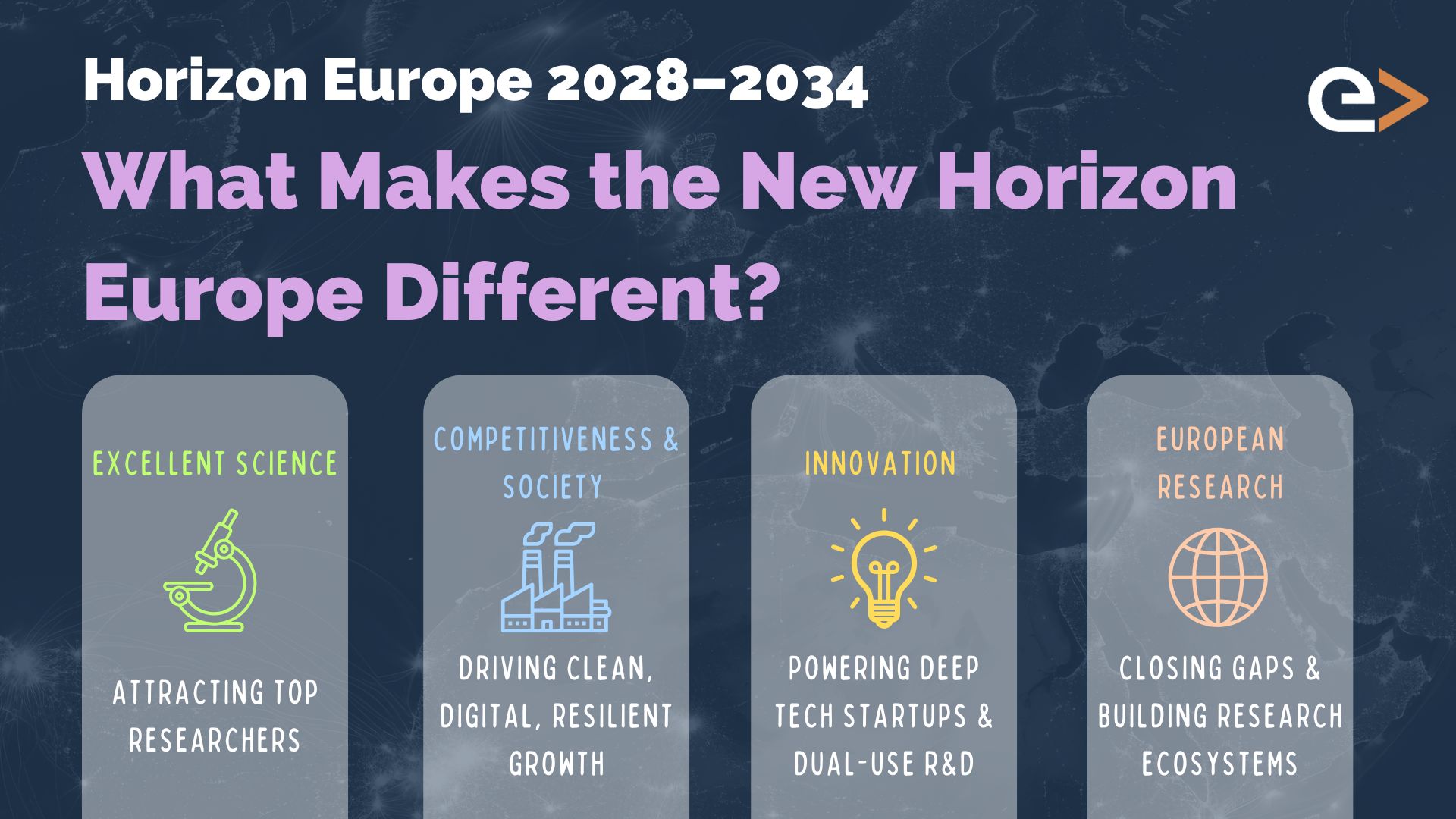Horizon Europe 2028–2034: A Bolder, Simpler, Faster Vision for European Innovation
The European Commission has unveiled its proposal for the next research and innovation framework, Horizon Europe 2028–2034. With a proposed €175 billion budget, twice the size of its predecessor, this new programme aims to be simpler, faster, and more strategic, accelerating Europe’s global competitiveness and leadership in key technological fields.
This bold investment underscores the EU’s ambition to drive science-led growth while addressing pressing societal and industrial challenges, from clean aviation and quantum computing to regenerative therapies and data sovereignty.
Curious what’s new and what it means for researchers, innovators, and startups? Here’s our breakdown.

🔸 What’s Changing, and Why It Matters
Boosting Research and Innovation
With a proposed €175 billion envelope, Horizon Europe 2028–2034 marks a historic commitment to research and innovation. According to the European Commission, each euro invested could generate up to €11 in GDP gains by 2045.
Reducing Bureaucracy to Accelerate Research
To make funding more accessible and efficient, the programme will implement several key improvements:
-
Unified funding rates and open-topic calls by default
-
Simplified grant processes, including lump-sum funding options
-
Shorter application-to-grant timelines
It will also align closely with the upcoming European Competitiveness Fund, reinforcing links between R&I, industrial resilience, and strategic autonomy.
🔸 Programme Structure: Four Pillars, One Mission
The 2028–2034 framework introduces a four-pillar structure, a shift from the previous programme’s three-pillar model. The new fourth pillar underlines the EU’s ambition to widen participation and strengthen the European Research Area.
Together, these pillars support the mission to enhance Europe’s science and innovation capacity, bolster global competitiveness, and deliver measurable societal and industrial impact.
Pillar I: Excellent Science (€44.1B)
Continued support for frontier research:
-
European Research Council (ERC): Funding curiosity-driven, top-tier research
-
Marie Skłodowska-Curie Actions: Supporting researcher mobility and career development
-
Joint Research Centre (JRC): Delivering scientific evidence for EU policy
This pillar remains consistent with the current Pillar I.
Pillar II: Competitiveness and Society (€75.9B)
The most significant component of the programme, focused on collaborative R&I for societal transformation:
-
Thematic areas include clean transition, health and biotech, digital leadership, defence, and space
-
Includes flagship initiatives like the EU Missions and the New European Bauhaus Facility
-
Closely linked with the European Competitiveness Fund
Builds on the current Pillar II, with more substantial industrial alignment.
Pillar III: Innovation (€38.8B)
Fueling deep tech and market-disrupting innovation:
-
Expansion of the European Innovation Council (EIC)
-
New emphasis on dual-use technologies and defence startups
-
Continued focus on scaling high-impact innovations from lab to market
This pillar reflects the previous Pillar III, with a stronger emphasis on dual-use and defence.
Pillar IV: European Research Area (€16.3B)
A new pillar, aimed at enhancing research excellence and access across Europe:
-
Support for research infrastructures and ecosystem development
-
Measures to address brain drain and improve regional R&I capacity
-
A new widening approach to ensure greater participation from all EU countries
A significant addition that strengthens cohesion and broadens EU-wide innovation capacity.

🔸 Strategic “Moonshots”: Turning Vision into Leadership
The proposal places significant emphasis on mission-oriented projects, referred to as “moonshots.” These are large-scale, high-ambition initiatives that connect R&I to tangible European leadership goals.
These projects will be supported through pooled funding, a mechanism combining financial resources from EU budgets, Member States, public institutions, and private investors, enabling joint action and increased impact.
Priority areas include:
-
Future Circular Collider
-
Quantum Computing
-
Next-Generation AI
-
Clean Aviation
-
Regenerative Therapies
-
Fusion Energy
-
Automated Mobility
-
Ocean Observation
-
Zero Water Pollution
-
Space Economy
-
Data Sovereignty
These are not abstract goals but strategic fields in which Europe aims to lead, ensuring long-term sovereignty and competitiveness.
🔸 Policy Foundations: Aligning with Strategic Priorities
The framework draws on key policy inputs that shape its strategic focus:
-
Mario Draghi’s Report on EU Competitiveness (2024): Recommends embedding R&I into the EU’s economic strategy
-
‘Much More than a Market’ by Enrico Letta: Introduces the ‘Fifth Freedom’, enabling the free movement of knowledge across the EU
-
‘Align, Act, Accelerate’ – Horizon Europe Interim Evaluation: Calls for a stronger alignment of R&I funding with long-term EU missions and industrial needs
These reports inspired the priorities of Horizon Europe 2028–2034 and provide a roadmap for policy, investment, and impact.
More details: Factsheet: Horizon Europe 2028–2034
🔸 What’s Next?
The proposal now enters interinstitutional negotiations between the European Commission, Parliament, and Council. Final adoption is expected ahead of the programme’s launch in 2028, allowing time to prepare implementation and transition.
🔸 We’re Ready to Help You Navigate What’s Next
Horizon Europe 2028–2034 represents an opportunity to strengthen Europe’s innovation landscape. With expanded funding, simplified access, and greater industrial alignment, the framework directly addresses the needs of researchers, startups, and SMEs.
We’re here to help you:
-
Navigate the new EU funding structure
-
Develop high-impact project ideas
-
Build successful cross-sector partnerships
Europe is investing in its future, let’s take advantage of the opportunity.

